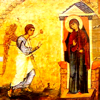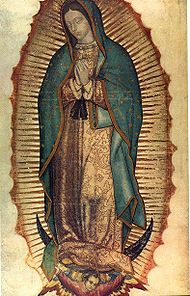03.1.2 Advent and Annunciation
Scripture and homily in brief for Advent/Annunciation Thursday, the Ultimate Thursday of the 12 Days of Gold of the Christmas Season.
Luke 1:26-38
26 In the sixth month [of Elizabeth’s pregnancy with John] the angel Gabriel was sent by God to a town in Galilee called Nazareth,
27 to a virgin engaged to a man whose name was Joseph, of the house of David. The virgin’s name was Mary.
28 And he came to her and said, ‘Greetings, favored one! The Lord is with you.’
29 But she was much perplexed by his words and pondered what sort of greeting this might be.
30 The angel said to her, ‘Do not be afraid, Mary, for you have found favor with God.
31 And now, you will conceive in your womb and bear a son, and you will name him Jesus.
32 He will be great, and will be called the Son of the Most High, and the Lord God will give to him the throne of his ancestor David.
33 He will reign over the house of Jacob for ever, and of his kingdom there will be no end.’
34 Mary said to the angel, ‘How can this be, since I am a virgin?’
35 The angel said to her, ‘The Holy Spirit will come upon you, and the power of the Most High will overshadow you; therefore the child to be born will be holy; he will be called Son of God.
36 And now, your relative Elizabeth in her old age has also conceived a son; and this is the sixth month for her who was said to be barren.
37 For nothing will be impossible with God.’
38 Then Mary said, ‘Here am I, the servant of the Lord; let it be with me according to your word.’ Then the angel departed from her.
Homily in Brief
 Although the calendar date for Advent/Annunciation is 1 December, the first of the 12 Days of Gold, the Reform officially celebrates the beginning of the Christmas Season today on the Ultimate Thursday of the dozenal.
Although the calendar date for Advent/Annunciation is 1 December, the first of the 12 Days of Gold, the Reform officially celebrates the beginning of the Christmas Season today on the Ultimate Thursday of the dozenal.
This differs significantly from other Christian traditions, which celebrate Advent four Sundays before Christmas, and celebrate the Annunciation (the day on which Mary was told by the Angel Gabriel that she would conceive Jesus) on 25 March, a materialist nine months of gestation prior to Christmas.
For the Reform, the biological placement of the Annunciation is not as important as the inspirational role it plays as part of the Nativity story. By observing this herald of the Nativity together with Advent, AUR brings the entire narrative of the birth of Jesus together in one ritual season, setting aside December as a month of preparing for new beginnings: the beginning of the life of Christ, the beginning of the era of the Tree of Life, and the beginning of the new year when December finally turns over to January.

 The AUR liturgical year opens with a series of holidays emphasizing the multi-cultural, multi-faith nature of American Reform Unitarian Christianity.
The AUR liturgical year opens with a series of holidays emphasizing the multi-cultural, multi-faith nature of American Reform Unitarian Christianity.